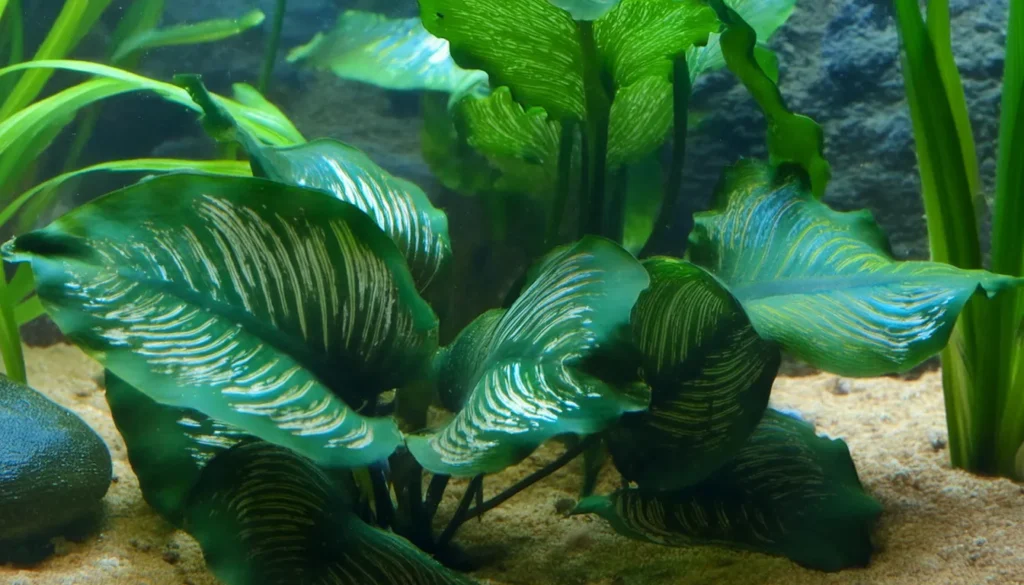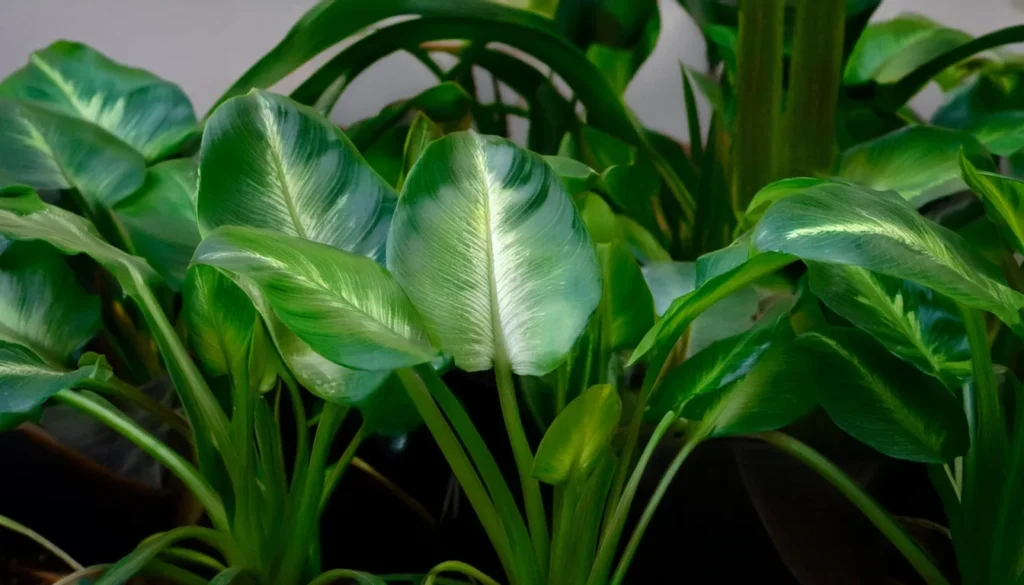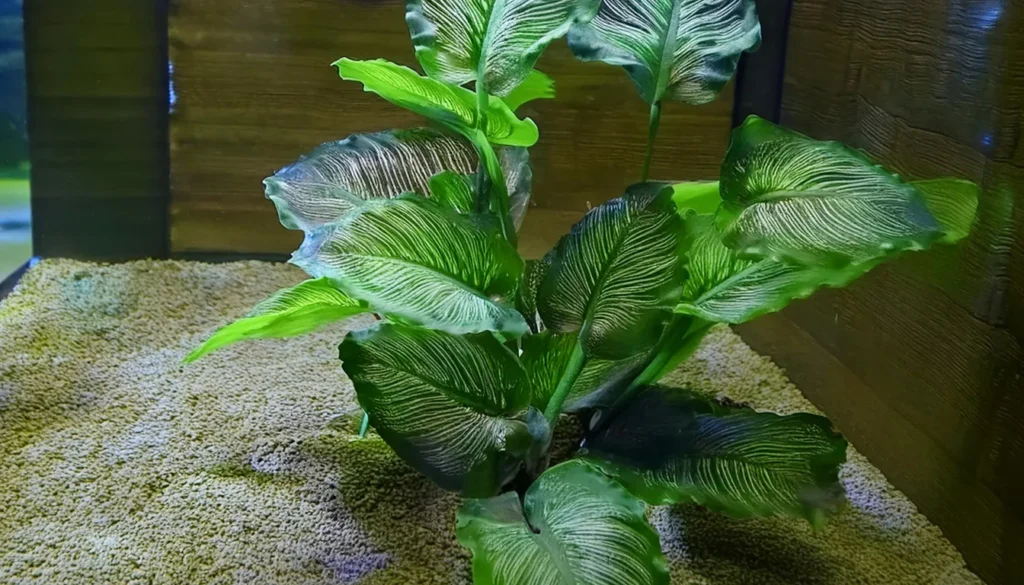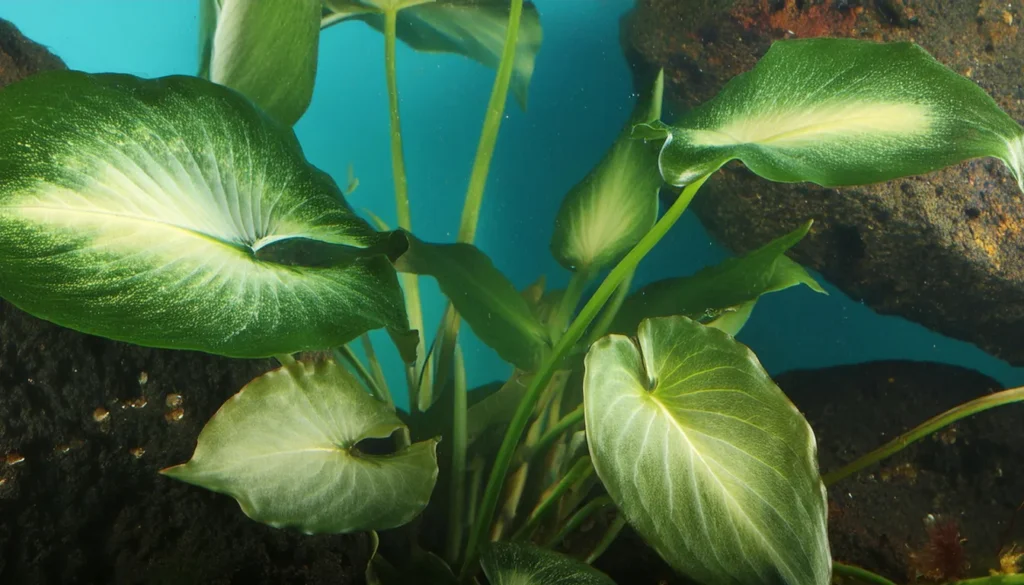Welcome to our comprehensive guide on aquascaping with Anubias Barteri! In this article, we will explore creative ideas for incorporating these beautiful aquatic plants into your aquariums.
Anubias Barteri is known for its vibrant green leaves, sturdy rhizomes, and versatility, making it a popular choice among aquascapes.
Whether you’re a beginner or an experienced hobbyist, we’ll provide you with all the information you need to successfully incorporate Anubias Barteri into your aquascapes.
With its lush foliage and unique growth patterns, Anubias Barteri can transform any aquarium into a captivating underwater oasis.
Not only do these plants add aesthetic appeal, but they also offer numerous benefits, such as providing natural habitat for fish and other aquatic organisms, enhancing water quality, and creating a sense of tranquility in your aquatic environment.
Throughout this article, we will cover everything you need to know about aquascaping with Anubias Barteri.
From selecting healthy specimens to strategic placement techniques, plant care essentials, and propagation methods, we’ll provide you with expert tips and insights to ensure the thriving growth of your Anubias Barteri plants.

Key Takeaway
- Anubias Barteri is a popular choice for aquascaping due to its vibrant green leaves and sturdy rhizomes.
- These plants provide natural habitat, enhance water quality, and create a sense of tranquility in aquariums.
- Selecting healthy specimens is crucial for ensuring the optimal growth of Anubias Barteri in your aquarium.
- Strategic placement techniques can create visually appealing displays and focal points within your aquascape.
- Proper care and propagation techniques are essential for maintaining a thriving Anubias Barteri garden.
Quick Stats
| Attribute | Details |
| Family Name | Araceae |
| Origin | West Africa |
| Height | 15-40 cm (6-16 inches) |
| pH Range | 6.0 – 7.5 |
| CO2 Requirement | Low to None |
| Growth Rate | Slow |
| Care Level | Easy |
| Color Form | Green |
| Water Conditions | 22-28°C (72-82°F), soft to moderately hard water |
| Max Size | Up to 40 cm (16 inches) in height |
| Lighting | Low to Moderate |
| Supplements | Iron-rich fertilizer for optimal growth |
| Placement | Mid-ground or Background |
| Propagation | Rhizome division |
Key Traits Of A Healthy Anubias Plant
A healthy Anubias Barteri plant exhibits several key traits that indicate its vitality and potential for growth. These traits include:
- Vibrant green leaves: Look for Anubias Barteri specimens with lush, vibrant green leaves. Healthy plants typically have leaves that are uniform in color and free from discoloration or browning.
- Sturdy rhizome: The rhizome, the horizontal stem from which Anubias Barteri leaves and roots arise, should be firm and intact. Avoid plants with soft or mushy rhizomes, which may indicate rot or decay.
- No signs of pests: Inspect the plant closely for any signs of pests, such as aphids or snail eggs. These can easily spread to other plants in your aquarium and cause damage.
- Well-developed root system: Healthy Anubias Barteri plants have well-developed roots that securely anchor the plant to the substrate. Avoid plants with sparse or damaged roots.

Spotting And Avoiding Unhealthy Anubias Specimens
To ensure the health and longevity of your aquascape, it is crucial to spot and avoid unhealthy Anubias Barteri specimens. Here are some signs that indicate an unhealthy plant:
- Algae growth: Unhealthy Anubias plants may exhibit excessive algae growth on their leaves. Algae can hinder the plant’s ability to photosynthesize and compromise its overall health.
- Physical damage: Avoid plants with torn or damaged leaves, as they may struggle to recover and grow properly.
- Disease or infection: Look for any signs of disease or infection, such as black spots, lesions, or unusual growths on the leaves or rhizome. Infected plants can spread diseases to other aquatic organisms in your aquarium.
Types Of Anubias Barteri
Anubias Barteri is a versatile plant species with various types, offering unique qualities and growth patterns. Let’s explore some of the popular varieties and species of Anubias Barteri:
Anubias Barteri var. Nana
Anubias Barteri var. Nana, also known as Dwarf Anubias, is one of the most popular types of Anubias Barteri.
It is characterized by its compact size and broad, dark green leaves. This variety is slow-growing and ideal for small aquariums or for creating foreground interest in larger setups.
Anubias Barteri var. Coffeefolia
Anubias Barteri var. Coffeefolia, also known as Coffee Leaf Anubias, is known for its unique, textured leaves that resemble coffee beans.
These leaves are often rich brown, adding a visually striking contrast to the aquatic landscape. Like other Anubias Barteri varieties, they are hardy and adaptable to a wide range of water conditions.
Anubias Barteri var. Broadleaf
Anubias Barteri var. Broadleaf is named for its large, round leaves that can grow up to several inches in diameter. This variety is perfect for creating a lush midground or background display in the aquarium.
Its impressive size and vibrant green color make it a focal point, adding a sense of depth and natural beauty to any aquascape.

Utilizing Anubias Barteri For Midground Interest
- Anubias Barteri is an excellent choice for creating midground interest in your aquascape. Placing these plants in the middle layers of the tank helps to add visual depth and a focal point.
- The dark green, broad leaves of Anubias Barteri create a striking contrast against other plants and hardscape elements.
- Consider placing Anubias Barteri between taller background plants and smaller foreground plants to create a seamless transition between the different layers of your aquascape.
- By strategically placing Anubias Barteri in the midground, you can create a visually pleasing arrangement that draws the viewer’s attention to the center of the tank.
Anchoring Anubias On Hardscape For Maximum Impact
- Anchoring Anubias Barteri on hardscape elements, such as rocks or driftwood, can elevate the visual impact of these plants. The sturdy rhizomes of Anubias Barteri make them ideal for attaching to hardscape materials, ensuring they stay securely in place.
- To anchor Anubias Barteri, simply attach the rhizome to the desired hardscape element using a fishing line or aquarium-safe glue. Do not bury the rhizome, as this can lead to rot.
- Position the Anubias Barteri to maximize its natural growth habit and showcase the beauty of its leaves.
- By anchoring Anubias Barteri on a hardscape, you can create striking focal points in your aquascape.
- The combination of the plants’ unique foliage and the textures of the hardscape materials will add an extra dimension to your underwater masterpiece.

Characteristics Of Anubias Barteri In Aquatic Environments
Anubias Barteri is a versatile aquatic plant that exhibits several unique characteristics when placed in underwater environments.
These characteristics contribute to their adaptability, visual impact, and overall appeal in aquascaping projects.
Let’s explore the key traits of This plant and why they are well-suited for aquatic environments:
- Adaptability to Various Water Parameters: Anubias Barteri is known for its ability to thrive in a wide range of water conditions. Whether it’s soft or hard water, acidic or alkaline, This plant can tolerate it all. This adaptability makes them suitable for different types of aquarium setups and allows aquarists to experiment with various water parameters without compromising the health of the plants.
- Tolerance for Low Lighting Conditions: It is ideal for aquariums with low-lighting setups. These plants can grow and flourish even in areas with limited light intensity. Their dark green leaves are equipped with a robust photosynthetic apparatus, enabling them to convert light into energy efficiently. As a result, they can survive and add visual interest to aquariums with minimal lighting requirements.
- Slow Growth Rate: It is known for its slow and steady growth. Unlike some fast-growing aquatic plants that require frequent trimming,This plant maintains a manageable size over time. This slow growth rate allows aquarists to maintain their aquascapes’ desired layout and aesthetics without the constant need for pruning or replanting.
- Broad, Dark Green Leaves: One of the key visual features of Anubias Barteri is its broad, dark green leaves. These leaves provide excellent visual coverage and add a sense of lushness to aquatic environments. They create a beautiful contrast against lighter-colored substrates or alongside other aquarium plants, enhancing the overall aesthetic appeal of the aquascape.

Essentials Of Aquatic Plant Care For Lush Anubias Growth
In order to promote the lush growth of Anubias Barteri in your aquarium, it is essential to provide proper care and create an optimal environment for these aquatic plants. Here are some key essentials to consider:
- Substrate Placement: Anubias Barteri can be planted directly into the substrate or attached to rocks or driftwood. The rhizome should be above the substrate to prevent rotting.
- Lighting Requirements: This plant is a low- to moderate-light plant. Provide them with a full spectrum of light by using LED lights or fluorescent lamps with a color temperature of around 6500K to 7500K.
- Water Temperature and pH Levels: It thrives in a temperature range of 72°F to 82°F (22°C to 28°C) and a pH range of 6.0 to 7.5.
- Regular Maintenance: Regular maintenance is crucial for the health and growth of this plant. Perform regular water changes to maintain water quality and prevent nutrient build-up. Additionally, prune any dead or yellowing leaves to promote new growth.

| Essential Care Tips for Lush Anubias Growth | |
| Substrate Placement | Plant directly into the substrate or attach to rocks or driftwood |
| Lighting Requirements | Low to moderate light; provide full spectrum light with 6500K – 7500K color temperature |
| Water Temperature | 72°F to 82°F (22°C to 28°C) |
| pH Levels | 6.0 to 7.5 |
| Regular Maintenance | Perform regular water changes and prune dead or yellowing leaves |
When And How To Propagate Anubias Barteri?
Anubias Barteri is a popular choice for aquascaping enthusiasts due to its lush foliage and ease of care.
Propagating This plant allows you to expand your aquatic garden and create new displays.
So, when is the best time to propagate Anubias Barteri? The ideal time to propagate this plant is during the growing season when it shows signs of active growth.
This typically occurs in the spring and summer months when the plant is in its prime.
To propagate Anubias Barteri, you can follow these steps:
- Inspect the parent plant: Select a healthy, mature Anubias Barteri specimen with robust growth. Ensure that the plant has multiple stems or stems with healthy-looking leaves. This ensures better success in propagation.
- Prepare the cutting: Using sharp, clean scissors or a sterile knife, carefully cut a portion of the rhizome, ensuring at least two leaves are attached to the stem.
- Separate the cutting: Gently wiggle the cutting until it separates from the parent plant. Be careful not to damage the roots or rhizome during this process.
- Choose suitable surfaces or substrates: Anubias Barteri can be propagated by attaching the cuttings to various surfaces or substrates. Popular choices include driftwood, rocks, or even the substrate itself. The roots will eventually attach to the chosen surface, and the cutting will start to grow.
- Secure the cutting: Attach the cutting to the chosen surface by using cotton thread, fishing line, or adhesive. Ensure that the cutting is securely fastened to prevent it from floating away or dislodging from the surface.
- Provide optimal conditions: Place the newly propagated cuttings in an aquarium with suitable water parameters, lighting, and filtration. This plant prefers low to moderate lighting and neutral to slightly acidic water conditions.
- Monitor and care for the cuttings: Regularly check the cuttings for signs of growth and health. Ensure the water quality is maintained and other plants do not overshadow the cuttings. Prune any dead or decaying leaves to maintain good plant hygiene.
RELATED: Alternanthera Bettzickiana Green Planting Detailed Guide
Caring For Anubias Cuttings To Ensure Successful Growth
To ensure the successful growth of your Anubias Barteri cuttings, it is essential to provide proper care and maintenance. Here are some key tips to keep in mind:
- Lighting: Anubias Barteri thrives under moderate lighting conditions. Avoid intense lighting, as it can lead to algae growth on the leaves. Provide a photoperiod of 8-10 hours per day to support healthy growth.
- Water parameters: It prefers water with a temperature range of 72-82°F (22-28°C) and a pH level between 6.0 and 7.5. It can tolerate various water hardness levels but prefers soft to moderately hard water.
- Fertilization: It is a slow-growing plant and has low nutrient requirements. However, you can supplement its growth by providing liquid or root fertilizers specifically formulated for aquatic plants. Pay attention to dosage instructions and avoid overdosing, which can lead to nutrient imbalances or algae issues.
- Pruning: Regularly trim any yellowing or decaying leaves to maintain the overall health and appearance of your Anubias Barteri. Use clean scissors or pruning shears to make clean cuts near the base of the leaf.
- Compatibility: Anubias Barteri is compatible with many fish and invertebrates. However, be cautious when placing it with herbivorous species, as they may nibble on the leaves. Avoid burying the rhizome in the substrate, as it can lead to rotting.

Creating An Iwagumi Aquascape
The Iwagumi aquascape style is a popular choice among aquascaping enthusiasts for its focus on simplicity and balance.
By incorporating Anubias Barteri into an Iwagumi aquascape, you can enhance your aquatic design’s visual interest and texture.
It is an ideal plant choice for Iwagumi aquascapes due to its low-maintenance nature and ability to thrive in various aquatic conditions.
Its dark green leaves provide a striking contrast against the rocks used in the Iwagumi style, creating a visually appealing and harmonious composition.
To create an Iwagumi aquascape with Anubias Barteri, follow these steps:
- Begin by selecting a suitable aquarium size and shape for your Iwagumi aquascape.
- Choose a centerpiece rock or stone that will serve as the focal point of your aquascape. Place it slightly off-center to adhere to the principle of asymmetry in the Iwagumi style.
- Position additional rocks or stones to complement the focal point, creating a sense of depth and balance.
- Introduce it by attaching the plants to the rocks using a fishing line or specialized plant adhesive. Be careful not to damage the plant’s rhizome during this process.
- Consider adding a few smaller rocks or pebbles around the base of the these plants to enhance their naturalistic look and add visual interest.
- Fill the aquarium with water, taking care to avoid disturbing the placement of the rocks and plants.
- Provide appropriate lighting and filtration for your Iwagumi aquascape, ensuring the this plant receives adequate light without causing excessive algae growth.
- To keep your Iwagumi aquascape looking its best, regularly monitor and maintain water parameters, perform necessary water changes, and trim any excess growth.

Emulating Natural Landscapes In Your Aquarium
- It is essential to emulate natural landscapes within your tank to create a stunning nature-inspired aquarium. One effective technique is to incorporate elements such as driftwood, rocks, and other natural materials. These elements add visual interest and provide hiding spots and grazing areas for your aquatic inhabitants.
- Driftwood can be strategically positioned to mimic fallen tree branches or submerged roots, creating a natural focal point. Rocks can be used to stack and create caves, cliffs, or even mountain-like formations. When selecting rocks, ensure they are aquarium-safe and won’t affect your tank’s water chemistry.
- Consider carefully arranging these elements to create a sense of depth and balance. Experiment with different combinations and arrangements, allowing your creativity to flourish while embracing the beauty of natural aesthetics.
Pairing Anubias Barteri With Suitable Fish And Invertebrates
When incorporating Anubias Barteri into your nature-inspired aquarium, it is crucial to choose suitable fish and invertebrates that will thrive in this environment.
Anubias Barteri provides natural shelter and grazing areas, making it an excellent addition to various aquatic setups.
Consider pairing this plant with fish species that prefer low-light conditions, such as tetras, rasboras, and certain catfish species.
These fish will appreciate the natural structure provided by the plants and will enhance the overall visual appeal of your aquarium.
For invertebrates,It offers a safe and nourishing habitat. Freshwater shrimp, like Cherry and amano shrimp, eagerly graze on the biofilm that naturally forms on the plant’s broad leaves.
The Benefits Of Using Anubias Barteri In Aquascapes
- Anubias Barteri is a must-have plant for creating beautiful and thriving aquascapes. The benefits of incorporating Anubias Barteri into your aquarium are numerous, making it a popular choice among aquarists.
- One of the key advantages of this plant is its aesthetic appeal. With its broad, dark green leaves and unique growth pattern, this plant adds a touch of natural beauty to any aquascape.
- Whether you’re going for a lush jungle or a minimalist layout, This plant can effortlessly enhance the visual appeal of your aquarium.
- Another significant benefit of Anubias Barteri is its low maintenance requirements. This plant is known for its hardiness and adaptability, making it suitable for both beginner and experienced aquarists.
- It can thrive in a wide range of water parameters, including low lighting conditions, making it a versatile choice for various aquascaping setups.
- Aside from its aesthetic and low-maintenance benefits, Anubias Barteri also provides a natural habitat and enrichment for aquatic organisms.
- This plant’s dense foliage and sturdy rhizome structure offer shelter and breeding spaces, promoting the well-being of fish, shrimp, and other aquarium inhabitants. It helps create a harmonious aquatic ecosystem, mimicking these organisms’ natural habitats.
- Thanks to its versatility, This plant is also well-suited for different aquascaping styles and layouts.
- Whether you prefer a traditional nature-inspired design or a contemporary Iwagumi aquascape, It can be easily incorporated to add texture, depth, and visual interest to your aquatic masterpiece.
Finding Optimal Lighting Conditions For Thriving Anubias Plants
Anubias Barteri has moderate lighting requirements and can thrive even under low to moderate light intensities.
However, understanding the optimal lighting conditions for this plant will greatly enhance its growth and overall appearance in your aquascape.
When determining the lighting conditions for Anubias Barteri, consider the following factors:
- Light Intensity: Anubias Barteri performs best under moderate light levels. Too much light can lead to excess algae growth, while insufficient light may cause stunted growth.
- Duration of Light Exposure: It requires approximately 8-10 hours of light exposure per day. Establishing a consistent lighting schedule is important to provide the necessary energy for photosynthesis.
- Light Spectrum: This plant responds well to full spectrum lighting, which replicates natural sunlight. This provides a balanced spectrum of wavelengths that supports healthy plant growth.
Nutritional Supplements To Promote Anubias Plant Growth
- In addition to providing adequate lighting, supplying the right nutrients is essential for promoting healthy growth in Anubias Barteri.
- While these plants can obtain some nutrients from the surrounding water and substrate, supplementing their diet with specialized fertilizers can significantly enhance their growth and appearance.
- One key nutrient that this plant requires for proper development is iron. Iron plays a crucial role in the plant’s ability to produce chlorophyll and carry out photosynthesis effectively.
- To ensure an adequate iron supply for your Anubias Barteri, consider dosing your aquarium with an iron-rich fertilizer or using root tabs that deliver essential nutrients directly to the plant’s roots.
- It’s important to note that while fertilization is beneficial, it should be done in moderation. Overdosing on fertilizers can lead to algae overgrowth and damage to your aquatic ecosystem.
Conclusion
Throughout this article, we have explored the wonderful world of aquascaping with Anubias Barteri and discovered a wealth of creative ideas for incorporating these plants into our aquariums.
From selecting the healthiest specimens to strategic placement techniques, we have learned how to maximize the beauty and impact of Anubias Barteri in our aquatic landscapes.
Anubias Barteri offers numerous benefits for aquascaping enthusiasts.
Not only do these plants add visual appeal with their vibrant green leaves and unique growth patterns, but they also provide a natural habitat for fish and other aquatic organisms.
Additionally, This plant is known for its low maintenance requirements, making it an ideal choice for both beginners and experienced aquarists.
As we conclude our journey, we encourage you to apply the tips and ideas shared in this article to your own aquascaping endeavors.
Whether you are striving for a nature-inspired aquarium or experimenting with the Iwagumi style, the versatility of Anubias Barteri will surely enhance your aquascape.
Frequently Asked Questions
How Can I Accelerate The Growth Rate Of Anubias Barteri, Given Its Notoriously Slow Growth?
Accelerating the growth of Anubias barteri involves optimizing its environment without compromising the plant’s health. Although naturally slow-growing, its growth can be encouraged by ensuring moderate lighting, stable CO2 levels (if added), and a nutrient-rich environment.
While this plant absorbs nutrients primarily from the water column, adding a liquid fertilizer can provide the necessary micro and macro nutrients. Keeping the water clean and performing regular water changes also support healthier, albeit still slow, growth.
What Advanced Techniques Can Be Used To Propagate Anubias Barteri More Effectively?
Propagation of Anubias barteri is typically done by rhizome division. For more effective propagation, carefully remove the plant from its attachment and use a sharp, sterilized knife to divide the rhizome, ensuring each section has at least 2-3 leaves.
To encourage quicker recovery and root development in the new cuttings, place them in areas with gentle water flow and adequate light. This can help the cuttings establish more rapidly than in stagnant conditions.
How Can I Prevent Or Treat Rhizome Rot In Anubias Barteri?
Rhizome rot in it is often due to poor water quality or burying the rhizome in the substrate, which it does not tolerate well. To prevent rot, always attach Anubias barteri to driftwood, rocks, or decoration above the substrate.
If rot is noticed, remove the plant from the tank, cut away the rotted parts of the rhizome with a sterilized knife, leaving only healthy tissue. Treat the cut surface with a fungicide recommended for aquarium plants, and improve tank conditions by increasing water circulation and performing regular water changes.
Can Anubias Barteri Adapt To Emersed Growth, And What Are The Benefits?
Yes, It can adapt to grow emersed (above water) and often thrives in these conditions, showing faster growth rates and larger leaves. Emersed cultivation can also encourage flowering. To transition Anubias barteri to emersed growth, maintain high humidity levels and keep the roots moist but not submerged.
This can be achieved in a paludarium setup or by using a humidity dome. Emersed growth reduces the risk of algae and aquatic pests, and can make propagation easier.
What Strategies Can Be Employed To Combat Algae Growth On Anubias Barteri Leaves Without Harming The Plant?
Combating algae on this plant involves addressing the underlying causes of algae growth, such as excessive light or nutrient imbalances. Reducing lighting duration to 6-8 hours per day, ensuring proper tank maintenance, and balancing nutrients can help minimize algae.
For algae that has already formed, gently wiping the leaves with a soft cloth or toothbrush can remove it without damaging the plant. Introducing algae-eating fish or invertebrates, like Otocinclus or Amano shrimp, can also help control algae growth on and around the plant
- Unveiling The Wonders Of Riccia Fluitans In Aquascapes - August 7, 2024
- Vallisneria Gigantea Var. Guide To Care And Cultivation At Home - July 31, 2024
- Vesicularia Dubyana Care & Growth Guide Tips For Beginner Gardeners - July 30, 2024
